#sir george hayter
Explore tagged Tumblr posts
Text

Queen Victoria in Coronation Robes
Artist: Sir George Hayter (English, 1792-1871)
Date: 1838
Medium: Oil on canvas
Collection: Private collection
Queen Victoria
Victoria (Alexandrina Victoria; 24 May 1819 – 22 January 1901) was Queen of the United Kingdom of Great Britain and Ireland from 20 June 1837 until her death in 1901. Her reign of 63 years and 216 days - which was longer than those of any of her predecessors - constituted the Victorian era. It was a period of industrial, political, scientific, and military change within the United Kingdom, and was marked by a great expansion of the British Empire. In 1876, the British parliament voted to grant her the additional title of Empress of India.
#queen victoria#portrait#painting#artwork#fine art#oil painting#royal throne#queen victoria of the united kingdom#historical portrait#historical scene#royal robes#royal crown#tiara#drapery#jewelry#full length#seated#english culture#english art#british royal family#british history#british empire#british monarchy#sir george hayter#english painter#european art#19th century painting
20 notes
·
View notes
Text

“Sir John Hayter (self-portrait)”, c.1820 by George Hayter (English, 1792-1871). National Portrait Gallery, London. oil on canvas
76 notes
·
View notes
Text
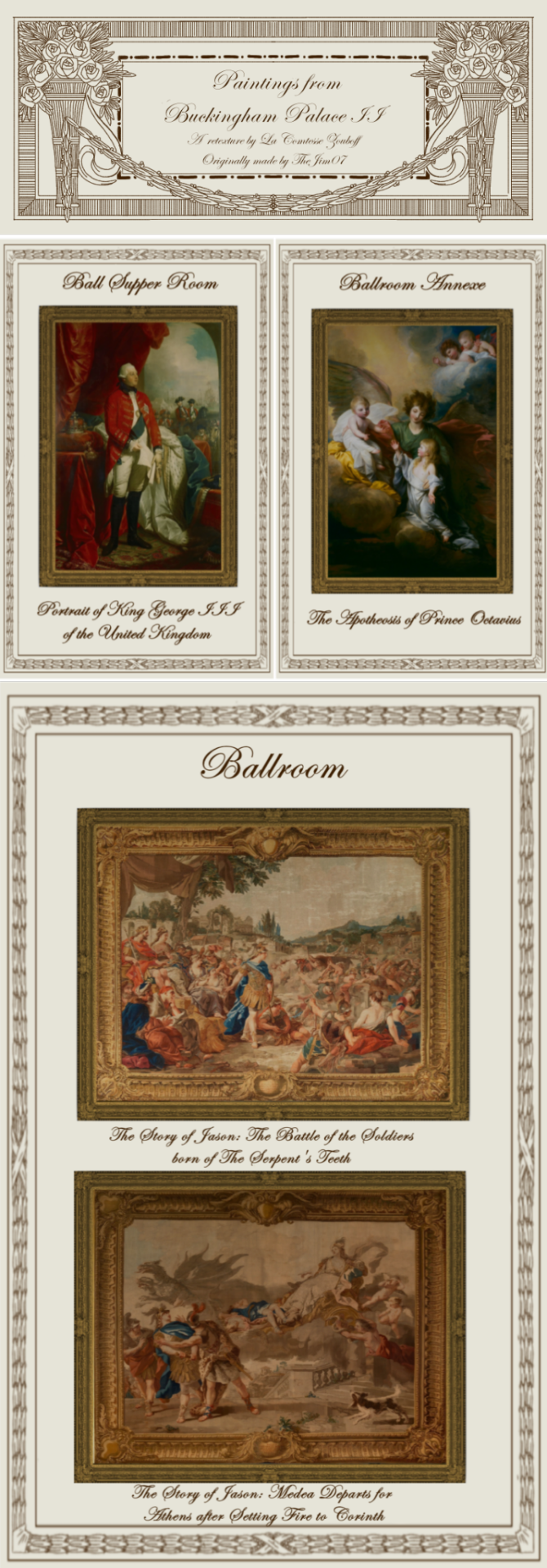
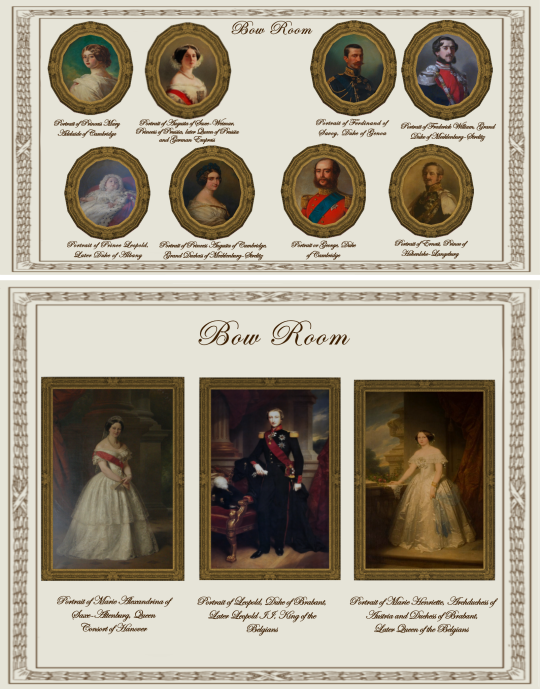
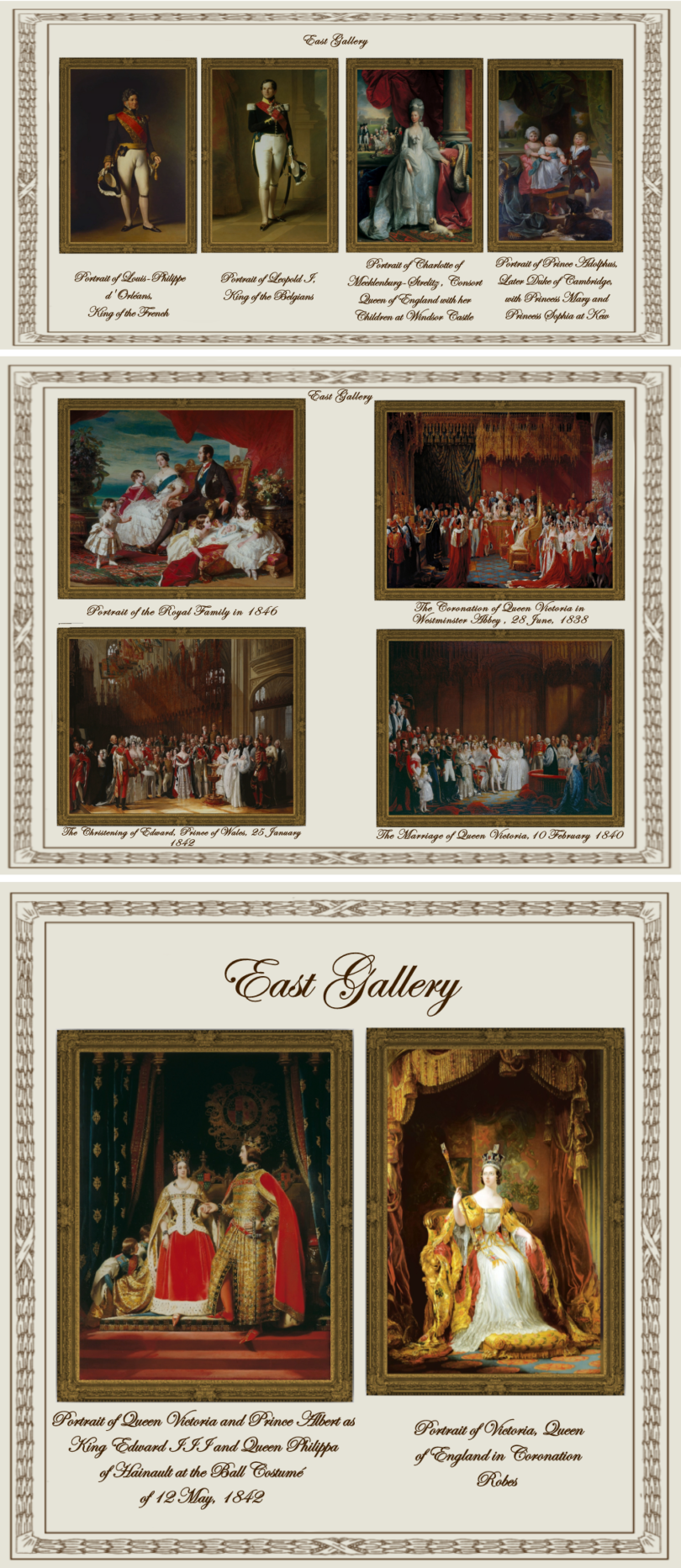
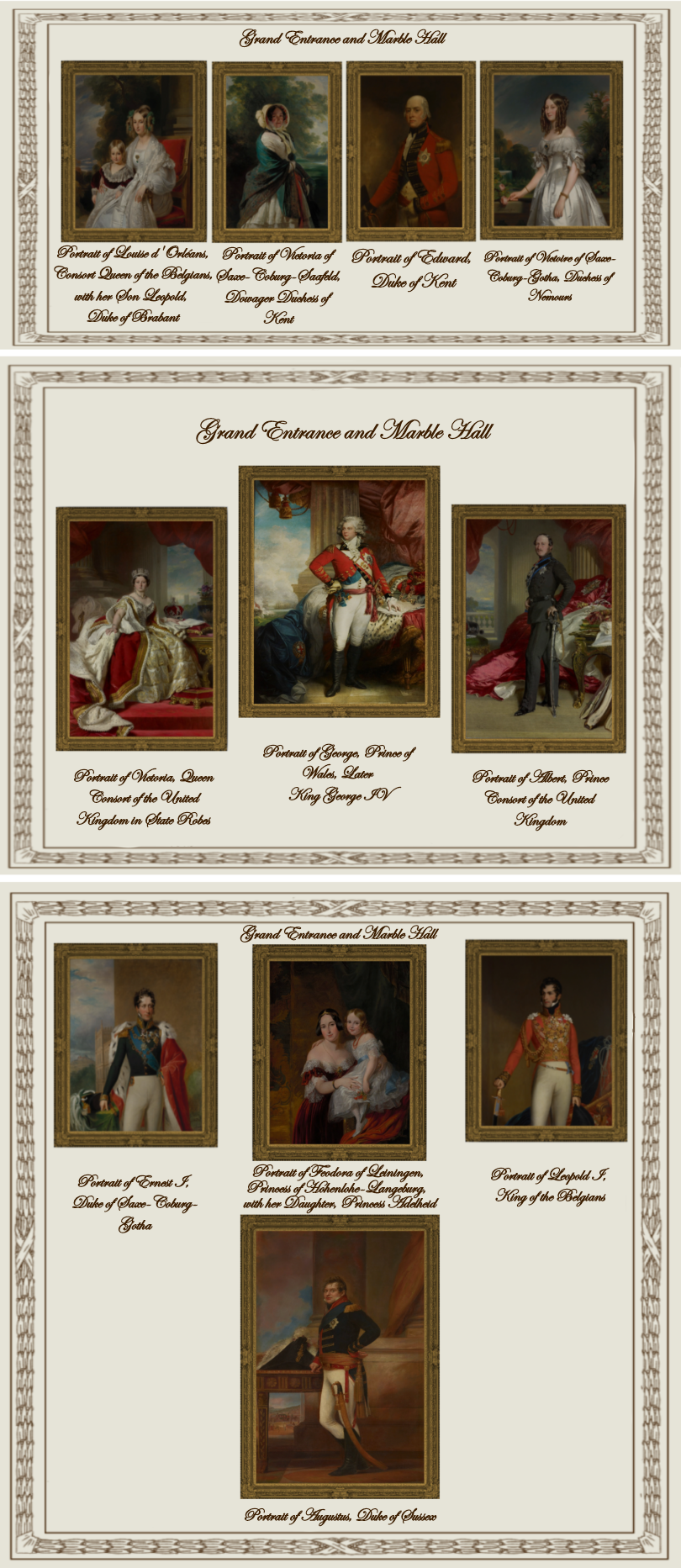

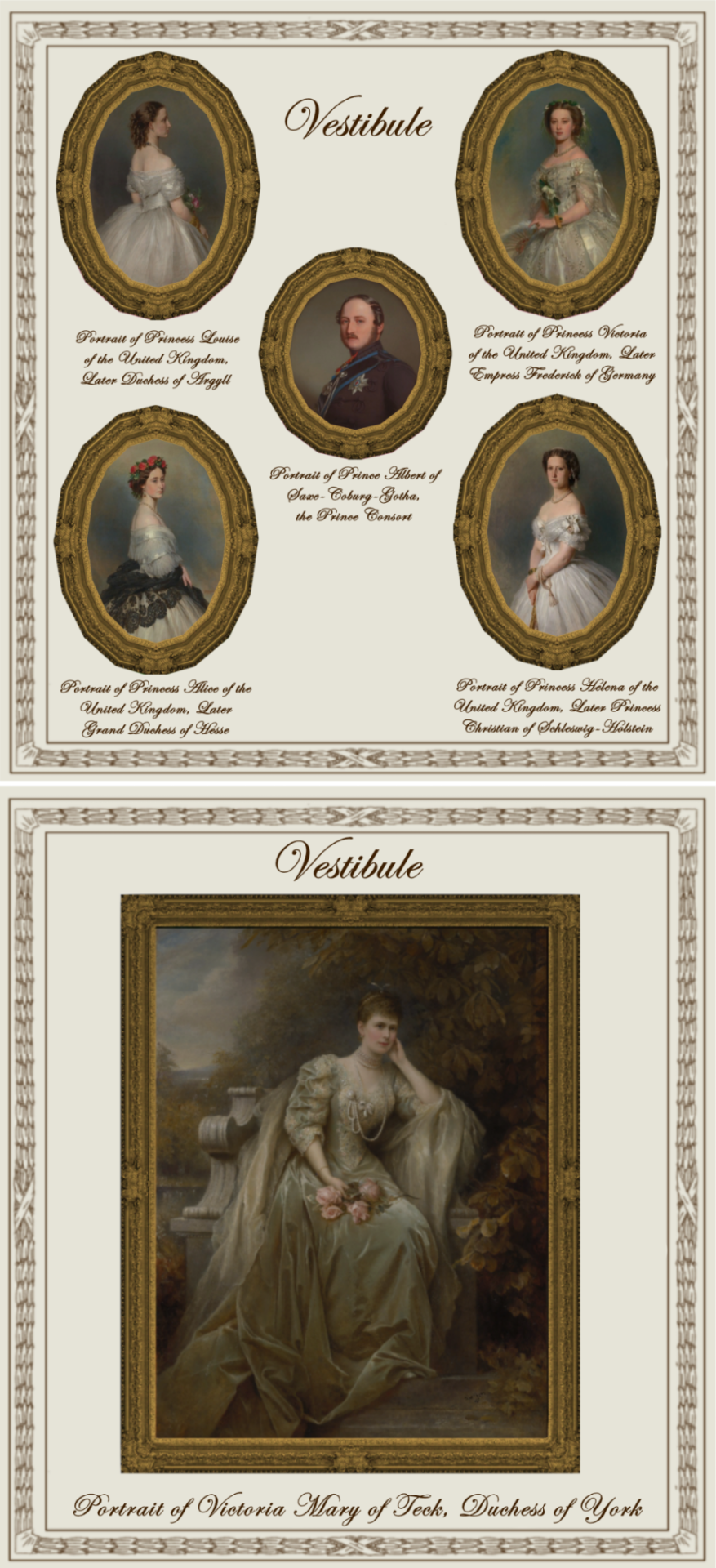
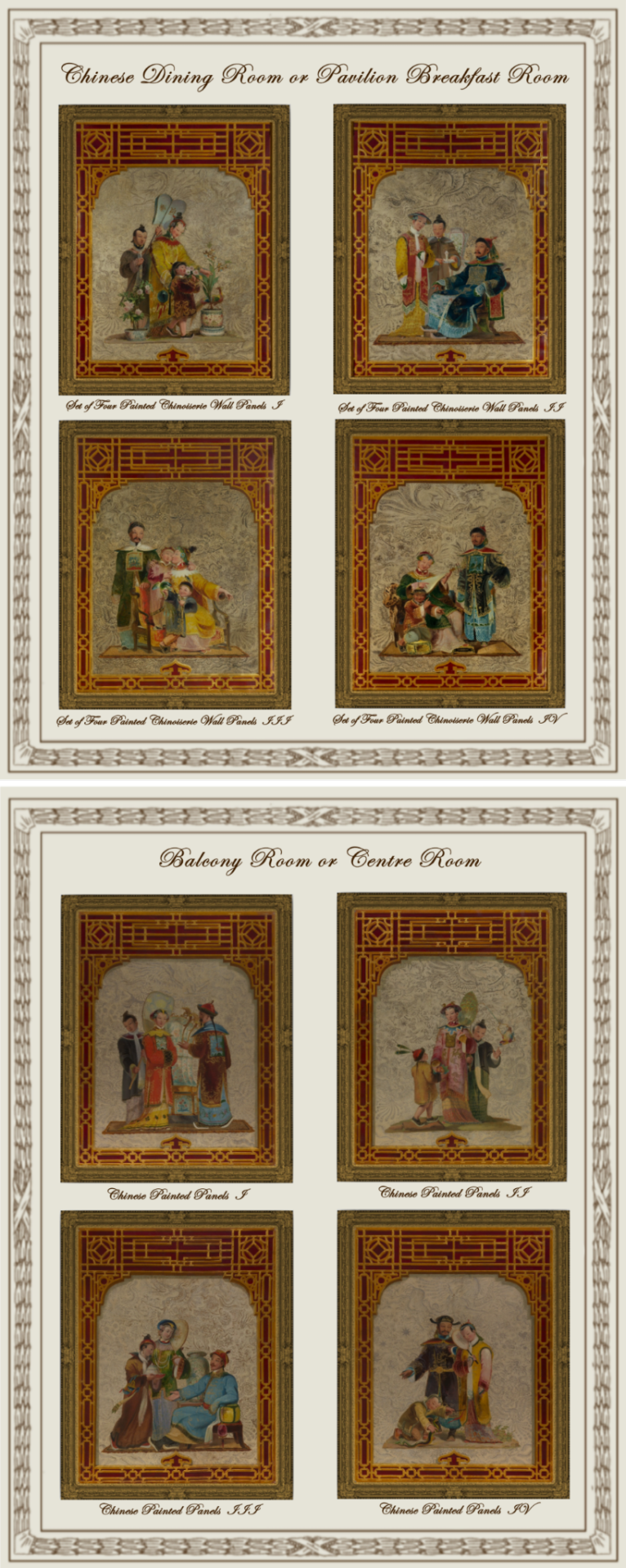

Paintings from Buckingham Palace: part II
A retexture by La Comtesse Zouboff — Original Mesh by @thejim07
Spread among 13 occupied and historic royal residences in the United Kingdom, the collection is owned by King Charles III and overseen by the Royal Collection Trust. The British monarch owns some of the collection in right of the Crown and some as a private individual. It is made up of over one million objects, including 7,000 paintings, over 150,000 works on paper, this including 30,000 watercolours and drawings, and about 450,000 photographs, as well as around 700,000 works of art, including tapestries, furniture, ceramics, textiles, carriages, weapons, armour, jewellery, clocks, musical instruments, tableware, plants, manuscripts, books, and sculptures.
Some of the buildings which house the collection, such as Hampton Court Palace, are open to the public and not lived in by the Royal Family, whilst others, such as Windsor Castle, Kensington Palace and the most remarkable of them, Buckingham Palace are both residences and open to the public.
About 3,000 objects are on loan to museums throughout the world, and many others are lent on a temporary basis to exhibitions.
-------------------------------------------------------
The second part includes paintings displayed in the Ball Supper Room, the Ballroom, the Ballroom Annexe, the Bow Room, the East Gallery, the Grand Entrance and Marble Hall, the Minister's Landing & Staircase, the Vestibule, the Chinese Dining Room and the Balcony Room.
This set contains 57 paintings and tapestries with the original frame swatches, fully recolourable. They are:
Ball Supper Room (BSR):
Portrait of King George III of the United Kingdom (Benjamin West)
Ballroom (BR):
The Story of Jason: The Battle of the Soldiers born of The Serpent's Teeth (the Gobelins)
The Story of Jason: Medea Departs for Athens after Setting Fire to Corinth (the Gobelins)
Ballroom Annexe (BAX):
The Apotheosis of Prince Octavius (Benjamin West)
Bow Room (BWR):
Portrait of Princess Mary Adelaide of Cambridge (William Corden the Younger)
Portrait of Princess Augusta of Cambridge, Grand Duchess of Mecklenburg-Strelitz (Alexander Melville)
Portrait or George, Duke of Cambridge (William Corden the Younger)
Portrait of Frederick William, Grand Duke of Mecklenburg-Strelitz (Franz Xaver Winterhalter)
Portrait of Augusta of Saxe-Weimar, Princess of Prussia, later Queen of Prussia and German Empress (Franz Xaver Winterhalter)
Portrait of Prince Leopold, Later Duke of Albany (Franz Xaver Winterhalter)
Portrait of Ernest, Prince of Hohenlohe-Langeburg (Franz Xaver Winterhalter)
Portrait of Ferdinand of Savoy, Duke of Genoa (Eliseo Sala)
Portrait of Marie Alexandrina of Saxe-Altenburg, Queen Consort of Hanover (Carl Ferdinand Sohn)
Portrait of Leopold, Duke of Brabant, Later Leopold II, King of the Belgians (Nicaise de Keyser)
Portrait of Marie Henriette, Archduchess of Austria and Duchess of Brabant, Later Queen of the Belgians (Nicaise de Keyser)
East Gallery (EG):
Portrait of Leopold I, King of the Belgians (Franz Xaver Winterhalter)
Portrait of Victoria, Queen of England in Coronation Robes (Sir George Hayter)
Portrait of Louis-Philippe d'Orléans, King of the French (Franz Xaver Winterhalter)
Portrait of Charlotte of Mecklenburg-Strelitz, Consort Queen of England with her Children at Windsor Castle (Benjamin West)
Portrait of Prince Adolphus, later Duke of Cambridge, With Princess Mary and Princess Sophia at Kew (Benjamin West)
The Coronation of Queen Victoria in Westminster Abbey, 28 June, 1838. (Sir George Hayter)
The Christening of Edward, Prince of Wales 25 January, 1842 (Sir George Hayter)
The Marriage of Queen Victoria, 10 February, 1840 (Sir George Hayter)
Portrait of the Royal Family in 1846 (Franz Xaver Winterhalter)
Portrait of Queen Victoria and Prince Albert as King Edward III and Queen Philippa of Hainault at the Ball Costumé of 12 May, 1842 (Sir Edwin Landseer)
Grand Entrance and Marble Hall (GEMH):
Portrait of Edward, Duke of Kent (John Hoppner)
Portrait of Ernest I, Duke of Saxe-Coburg-Gotha (George Dawe)
Portrait of Victoria of Saxe-Coburg-Saafeld, Dowager Duchess of Kent (Franz Xaver Winterhalter)
Portrait of Albert, Prince Consort of the United Kingdom (Franz Xaver Winterhalter)
Portrait of Victoria, Queen Consort of the United Kingdom in State Robes (Franz Xaver Winterhalter)
Portrait of Louise d'Orléans, Consort Queen of the Belgians, with her Son Leopold, Duke of Brabant (Franz Xaver Winterhalter)
Portrait of Feodora of Leiningen, Princess of Hohenlohe-Langeburg, with her Daughter, Princess Adelheid (Sir George Hayter)
Portrait of George, Prince of Wales, Later King George IV (Mather Byles Brown)
Portrait of Victoire of Saxe-Coburg-Gotha, Duchess of Nemours (Franz Xaver Winterhalter)
Portrait of Augustus, Duke of Sussex (Domenico Pellegrini)
Portrait of Leopold I, King of the Belgians (William Corden the Younger)
Minister's Landing and Staircase (MLS):
Portrait of George, Prince of Wales in Garther Robes (John Hoppner)
The Loves of the Gods: The Rape of Europa (the Gobelins)
The Loves of the Gods: The Rape of Proserpine (The Gobelins)
Vestibule (VL):
Portrait of Prince Albert of Saxe-Coburg-Gotha, the Prince Consort (Unknown Artist from the German School)
Portrait of Princess Alice of the United Kingdom, Later Grand Duchess of Hesse (Franz Xaver Winterhalter)
Portrait of Princess Helena of the United Kingdom, Later Princess Christian of Schleswig-Holstein (Franz Xaver Winterhalter)
Portrait of Princess Louise of the United Kingdom, Later Duchess of Argyll (Franz Xaver Winterhalter)
Portrait of Princess Victoria of the United Kingdom, Later Empress Frederick of Germany (Franz Xaver Winterhalter)
Portrait of Victoria Mary of Teck, Duchess of York (Edward Hughes)
Chinese Dining Room or Pavilion Breakfast Room(CDR):
Set of Four Painted Chinoiserie Wall panels I (Robert Jones)
Set of Four Painted Chinoiserie Wall panels II (Robert Jones)
Set of Four Painted Chinoiserie Wall panels III (Robert Jones)
Set of Four Painted Chinoiserie Wall panels IV (Robert Jones)
Balcony Room or Centre Room (BR):
Chinoiserie Painted Panel I (Robert Jones)
Chinoiserie Painted Panel II (Robert Jones)
Chinoiserie Painted Panel III (Robert Jones)
Chinoiserie Painted Panel IV (Robert Jones)
EXTRAS! (E):
I decided to add the rest of the tapestries from the story of Jason (wich hangs in the Grand Reception Room at Windsor Castle) and (with Jim's permission) added the original mesh for paintings number 2,3,4 & 5 from the Vestibule (seen here and here) wich was never published. These items are:
The Story of Jason: Jason Pledges his Faith to Medea (the Gobelins)
The Story of Jason: Jason Marries Glauce, Daughter of Creon, King of Thebes (the Gobelins)
The Story of Jason: The Capture of the Golden Fleece (the Gobelins)
The Story of Jason: The Poisoning of Glauce and Creon by Medea's Magic Robe (the Gobelins)
Sea Melodies (Herbert James Draper) (made by TheJim07)
-------------------------------------------------------
Found under decor > paintings for:
500§ (BWR: 1,2,3,4,5,6, & 8 |VL: 1)
570§ (VL: 2,3,4 & 5 |E: 5)
1850§ (GEMH: 1 & 3)
2090§ (GEMH: 2,6,7, 9 & 11)
3560§ (GEMH: 4,5 & 10 |BSR: 1 |EG: 1,2,3,4 & 5 |MLS: 1 |BAX: 1)
3900§ (CDR: 1,2,3 & 4 |BR: 1,2,3 & 4 |EG: 10 |VL: 6 |GEMH: 8)
4470§ (MLS: 2 |E: 1)
6520§ (BR 1 & 2| MLS: 3 |EG: 6,7,8 & 9 |BR: 1 & 2 |E: 2,3 & 4)
Retextured from:
"Saint Mary Magdalene" (BWR: 1,2,3,4,5,6, & 8 |VL: 1) found here.
"Sea Melodies" (VL: 2,3,4 & 5 |E: 5)
"The virgin of the Rosary" (GEMH: 1 & 3) found here.
"Length Portrait of Mrs.D" (GEMH: 4,5 & 10 |BSR: 1 |EG: 1,2,3,4 & 5 |MLS: 1 |BAX: 1) found here
"Portrait of Maria Theresa of Austria and her Son, le Grand Dauphin" (CDR: 1,2,3 & 4 |BR: 1,2,3 & 4 |EG: 10 |VL: 6 |GEMH: 8) found here
"Sacrifice to Jupiter" (MLS: 2 |E: 1) found here
"Vulcan's Forge" (BR 1 & 2| MLS: 3 |EG: 6,7,8 & 9 |BR: 1 & 2 |E: 2,3 & 4) found here
(you can just search for "Buckingham Palace" using the catalog search mod to find the entire set much easier!)
Disclaimer!
Some paintings in the previews look blurry but in the game they're very high definition, it's just because I had to add multiple preview pictures in one picture to be able to upload them all! Also sizes shown in previews are not accurate to the objects' actual sizes in most cases.
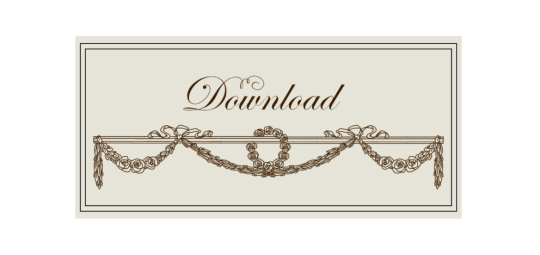
Drive
(Sims3pack | Package)
(Useful tags below)
@joojconverts @ts3history @ts3historicalccfinds @deniisu-sims @katsujiiccfinds @gifappels-stuff
-------------------------------------------------------
#the sims 3#ts3#sims 3#s3cc#sims 3 cc#sims 3 download#sims 3 decor#edwardian#victorian#regency#georgian#buckingham#buckingham palace#wall decor#sims 3 free cc#large pack#this was exhausting
87 notes
·
View notes
Note
So what about the leading men? How do you think they would get on with each other? Honestly I'm interested in any and all your cross-universe opinions: heroine/leading man friendships, between the older gents and ladies...
Follow-up to the female version. I find the men harder. And again, I think the heroes would all basically get along because they are all decent people with similar worldviews.
Best Friends:
Charles Bingley & Everyone, this man is friends with Darcy pre-reformation, enough said. Also, him and Sir John Middleton & Charles Musgrove have a special bond and magnificent house parties.
Henry Crawford & Everyone... at first. Then they start to realize what he's really like (except Edmund, takes him longer)
Tom Bertram, Frank Churchill & John Willoughby, disaster pairing
Colonel Brandon & Captain Wentworth, bond over their mutual time in the military. They are also both hopeless romantics. They get drunk and cry one evening about Eliza 1 and how Wentworth should have written Anne sooner.
Fitzwilliam Darcy & Henry Tilney, Henry is the male version of Elizabeth, so obviously Darcy has to bring him home and show his wife.
George Knightley & Fitzwilliam Darcy, Darcy reminds Knightley of Emma, but they mostly bond over estate management.
Henry Tilney, Edmund Bertram, Charles Hayter, and Edward Ferrars, the country clergyman club, Mr. Collins is not invited.
Mentor/Mentee:
Mr. Knightley & Edmund Bertram, Edmund really needs some life advice from someone older and not his father. And we know he won't listen to women, so I hope he'll listen to Knightley.
Captain Wentworth & Lt. William Price, best captain ever!
Henry Tilney & Edward Ferrars, Edward wants some advice on being a clergyman but they also bond over having shitty families.
Bonus: Sir Thomas Bertram & Sir Walter Elliot are both in parliament, they hate each other.
Also, an anon asked the same question basically:

I don't think Henry Tilney would be anyone's mentor except Edward Ferrars, because he's either the same age or younger than most of them. He is the eldest of the country preachers but not by a whole lot. But Edmund is bad at advice taking... All of them should take his advice on flirting but they won't.
#question response#austen heroes#mansfield park#pride and prejudice#northanger abbey#sense and sensibility#emma#persuasion
147 notes
·
View notes
Text
Queen Victoria’s Famous White Wedding

The image is from Sir George Hayter’s painting “The Marriage of Queen Victoria.”
When Queen Victoria (1819-1901) and Prince Albert (1819-1861) were married in 1840, Victoria made the unconventional decision to wear a white dress.
Her “white wedding” was a sensation, and well-to-do brides in Britain and America began immediately to imitate her.
By the early to mid-20th century, brides of all social stations had begun to choose white and, of course, by our era, white wedding dresses have become de rigueur.
Within a decade of Queen Victoria’s famous white wedding, a popular and influential American women’s magazine published an article declaring that brides had worn white from time immemorial and that the color was chosen because it symbolized purity and virginity.
“Custom has decided, from the earliest ages, that white is the most fitting hue, whatever may be the material. It is an emblem of the purity and innocence of girlhood, and the unsullied heart she now yields to the chosen one,” wrote an editor of Godey’s Lady’s Book.
But actually, women rarely wore white dresses at their weddings before Queen Victoria wore one.
Before Victoria’s wedding, only an eccentric woman would have chosen to be married in a dress that wasn’t colorful.
A white dress would have been considered a very unusual choice. Moreover, while a woman would wear her best dress for her wedding, there was no such thing as a specialized “wedding dress.”
So, in fact, the custom of wearing white wedding dresses originated not in some ancient tradition as a symbol of purity, but rather in the wedding of Queen Victoria and Prince Albert, which occurred on 10 February 1840.
#queen victoria#prince albert#british royal family#victorian era#white wedding#white wedding dress#wedding dress#wedding#brides#royal wedding#royal wedding 1840 #1800s#19th century
19 notes
·
View notes
Text



28 June 1838: The Coronation of 19 year old Queen Victoria (painted by Sir George Hayter), guests included the first female sociologist and social theorist Harriet Martineau (painted by Richard Evans) who Victoria invited having been an admirer since Martineau’s earliest work Illustrations of Political Economy. 185 Years later Martineau’s 4x grand-niece, The Princess of Wales attended the coronation of Charles III.
#On this day#Otd#princess of wales#Queen Victoria#Charles iii#harriet martineau#Coronation#British royal family#Art#art history#KTD#Kate Middleton#Coronation 1838
105 notes
·
View notes
Text












Vote for your favourite, the top 9 will proceed in the bracket. Since theyre all different shapes and sizes, make sure to click into the full views!
Paget Eliminations // Other Artist Eliminations
Full captions and details for each illustration below the cut:
All Sidney Paget illustrations are for the Strand Jul 1891 - Dec 1904
"He tore the mask from his face." Scandal in Bohemia Characters: King of Bohemia, Watson, Holmes
"For a long time he remained there." Boscombe Valley Characters: Holmes
"Her face blanched with terror." Speckled Band Characters: Julia and Helen Stoner
"Arthur caught him." Beryl Coronet Characters: Arthur Holder, Sir George Burnwell
"What may you be wantin'?" Yellow Face Characters: Scotch Housekeeper, Grant Munro
"The point is a simple one." Reigate Squires Characters: Colonel Hayter, Mr Acton, Watson, Holmes
"The view was sordid enough." Naval Treaty Characters: Watson, Holmes
"He glanced swiftly over it." Hound of the Baskervilles Characters: Dr Mortimer, Sir Henry, Watson, Holmes
"It was a prostrate man face downwards upon the ground." Hound of the Baskervilles Characters: Selden, Holmes, Watson
"A little, wizened man darted out." Norwood Builder Characters: Oldacre, Watson, Holmes, Lestrade, Police
"He sank down upon the sea-chest, and looked helplessly from one of us to the other." Black Peter Characters: John Hopley Neligan, Hopkins, Holmes, Watson
"Holmes had bounded across the room and had wrenched a small phial from her hand." Golden Pince-nez Characters: Prof Coram, Watson, Holmes, Anna, Hopkins
#acd holmes#sherlock holmes#tumblr bracket#sherlock holmes illustrations#elim poll#sp elim#polls full bracket
34 notes
·
View notes
Text




Fashion History Challenge 2025 day 10 (1830s)
For day 10 of @foreverinthepagesofhistoryy challenge i chose paintings of Queen Victoria from her coronation. With similar portraits of her predecessor King William IV and his wife Queen Adelaide.
The portraits of William IV and Queen Adelaide are not exactly coronation portraits, but it does show them with their crowns. William IV became King in 1830 and had his and Queen Adelaide's coronation in 1831. Due to George IVs extremely lavish coronation and his own dislike of the ceremonial, he and the government wanted to spend as little as possible on it, making some call it the half crown-nation.
The portrait of Queen Adelaide was painted by John Simpson in 1832. Beside her sits her own crown. The portrait of William IV was painted by Sir William Beechey and it was painted around the same time as Queen Adelaide's. Beside William Iv is Saint Edward's crown.
Queen Victoria became Queen in 1837 and had her coronation in 1838. While William IVs coronation had cost £30,000 and George IVs had cost £240,000, Queen Victoria's coronation cost £70,000 as a compromise between the two. Queen Victoria hired the painter George Hayter to paint her coronation less than a week before the event.
George Hayter painted the first portrait, called Queen Victoria taking the Coronation Oath, as a companion piece to the larger main painting. The second portrait was commissioned at a later date, as Queen Victoria's state portrait. It too is painted by George Hayter and Queen Victoria is wearing her coronation garb with the imperial state crown and the sceptre with the cross.
Photos and info taken from wikipedia
#historical fashion challenge 2025#im really happy i could do a coronation vs coronation thing#also says Hayter was paid 2000 guineas for the coronation#but it didnt state what that was relative to £ or today
4 notes
·
View notes
Text

Queen Victoria’s Coronation Westminster Abbey 28 June 1839 oil on canvas Sir George Hayter
#coronation#england#god save the queen#queen victoria#royal portraits#british art#british history#british royal family
0 notes
Text

The Marriage of Queen Victoria, 10 February 1840
Artist: Sir George Hayter (English, 1792-1871)
Date: 1840-1842
Medium: Oil on canvas
Collection: Royal Collection Trust, United Kingdom
Description
The ceremony took place on the morning of 10 February 1840 in the Chapel Royal, St James's Palace. Queen Victoria and Prince Albert clasp hands at the altar rails, before the Archbishop of Canterbury.
The Queen had been pleased with Sir George Hayter's painting of her Coronation 'which we thought a fine thing', and commissioned him to paint her marriage, in particular the moment of the joining of hands.
Hayter had been to see the Chapel Royal a few days before the event, and sketched hard before and during the ceremony. Preparatory drawings survive in the British Museum. As in his Coronation, Hayter decided to alter dramatically the setting of the ceremony from what it actually looked like. The tall Gothic canopy and the panelling below are invented and only the details of the huge door behind the bridal pair may have been suggested by the much smaller door at the entrance to the Chapel Royal.
Hayter included portraits of 56 of those present at the occasion and sittings took place over the next year. The Queen sat for him in March in her 'Bridal dress, veil, wreath & all', and Prince Albert also posed for his portrait several times during the following months. Hayter's family too helped out with his son, Henry, modelling the Prince's costume, while his daughter Mary posed for the Queen's arm and wearing the veil. Victoria's aunt Queen Adelaide, however, was unwilling to co-operate and the artist had to refer to a miniature for her likeness. Hayter included himself in the painting, on the lower right, with his sketchbook and pencil.
By the end of the year Hayter was committing himself to a third large picture of the Christening of the newly-born Prince of Wales, and Prince Albert said that the Marriage picture should be hung at Windsor during the festivities. When Hayter went to see it, however, he was disappointed as it was hung between windows with its back to the light, unlike the new portraits by Winterhalter which were hung in a beautiful light. The artist returned to London 'heavy hearted'.
#portrait#marriage ceremony#queen victoria#prince albert#marriage of queen victoria#painting#oil on canvas#fine art#oil painting#british history#ceremony#british monarchy#archbishop of canterbury#chapel royal#bridal dress#costume#men#women#sir george hayter#english painter#english culture#royal collection trust#19th century painting#artwork#european art
21 notes
·
View notes
Photo

The Music Lesson, Sir George Hayter, 1830
#the music lesson#sir George hayter#hayter#George hayter#painting#art#portrait#1830#1830s#1800s#19th century
50 notes
·
View notes
Photo





Supertunica worn by Queen Victoria at her coronation, June 28, 1838. Depicted in a portrait by Sir George Hayter ca. 1838-40.
From the Royal Collection
#19th century#victorian#1830's#supertunica#coronation robes#queen victoria#history#royalty#art#portrait#sir george hayter
1K notes
·
View notes
Text

At last I was well enough to return to my duty; and glad I was to be once more walking the quarter-deck, not as before, on the lee, but on the weather side, with an epaulet on my shoulder.
— Frederick Marryat, Percival Keene
Portrait of Captain Forster attributed to the circle of Sir George Hayter (1792-1871)
#frederick marryat#captain marryat#age of sail#royal navy#uniform#percival keene#naval portrait#sir george hayter#captain forster
22 notes
·
View notes
Photo

Mary, Duchess of Gloucester (1776-1857)
Sir George Hayter, c.1838
6 notes
·
View notes
Photo


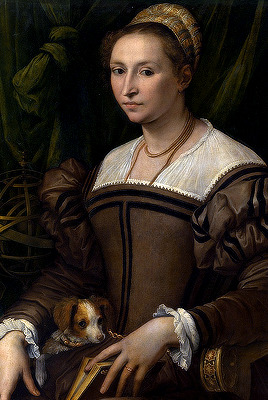





LADIES & THEIR COMPANION DOGS
Jodie Comer as Marguerite De Carrouges · The Last Duel (2021) / Christine de Pizan in her study (detail), c. 1410-14
Joss Stone as Anne of Cleves · The Tudors (2007-2010) / Portrait of a Lady with a Dog, by Master of the Jacquemart-André Lutenist, c. 1540-50
Simone Ashley as Kate Sharma & Austin as Newton · Bridgerton (2020-) / Lady Maria Conyngham, by Sir Thomas Lawrence, c. 1824-25
Emily Blunt as Queen Victoria & Tori as Dash · The Young Victoria (2009) / Princess Victoria and Dash, by George Hayter, c. 1866-70
#jodie comer#marguerite de carrouges#the last duel#thelastdueledit#joss stone#anne of cleves#the tudors#thetudorsedit#simone ashley#kate sharma#Bridgerton#bridgertonedit#emily blunt#queen victoria#the young victoria#theyoungvictoriaedit#perioddramaedit#weloveperioddrama#perioddramasource#onlyperioddramas#mine#women tag#don't look too closely into this or i'll cry#art
2K notes
·
View notes
Text

Patron of the Gallery, The Princess of Wales with Gallery Director, Nicholas Cullinan walk by a portrait of Queen Victoria by Sir George Hayter as they tour the National Portrait Gallery after a 3 year renovation. Nicholas posted on Instagram saying ‘thank you for coming and for all your wonderful support! ❤️’.
34 notes
·
View notes